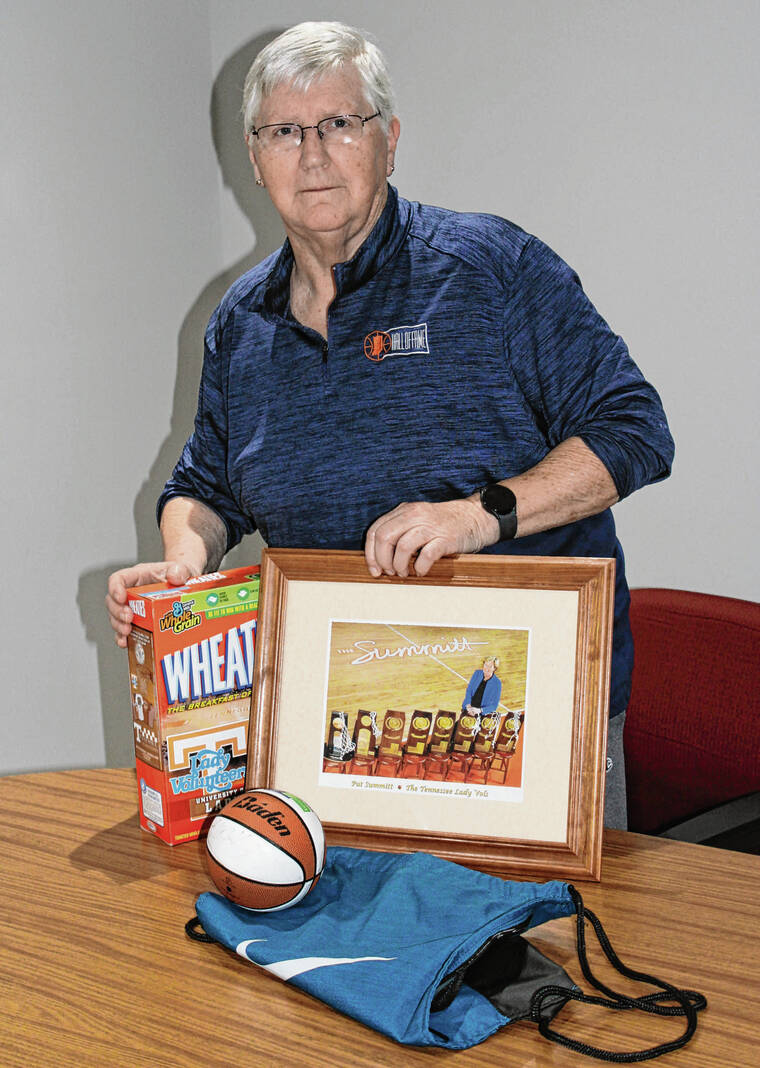
Seymour’s Donna Sullivan showing off some of her favorite women’s basketball memorabilia items.
Lew Freedman | The Tribune
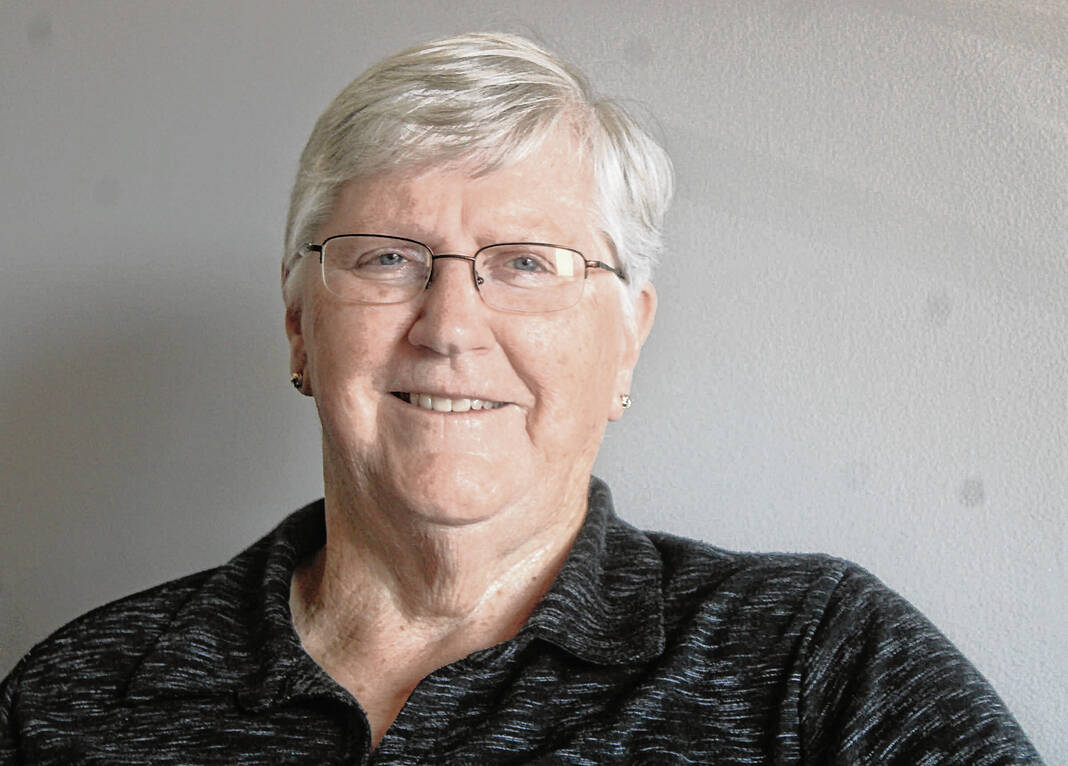
Seymour’s Donna Sullivan is the first female president of the Indiana Basketball Hall of Fame.
Lew Freedman | The Tribune
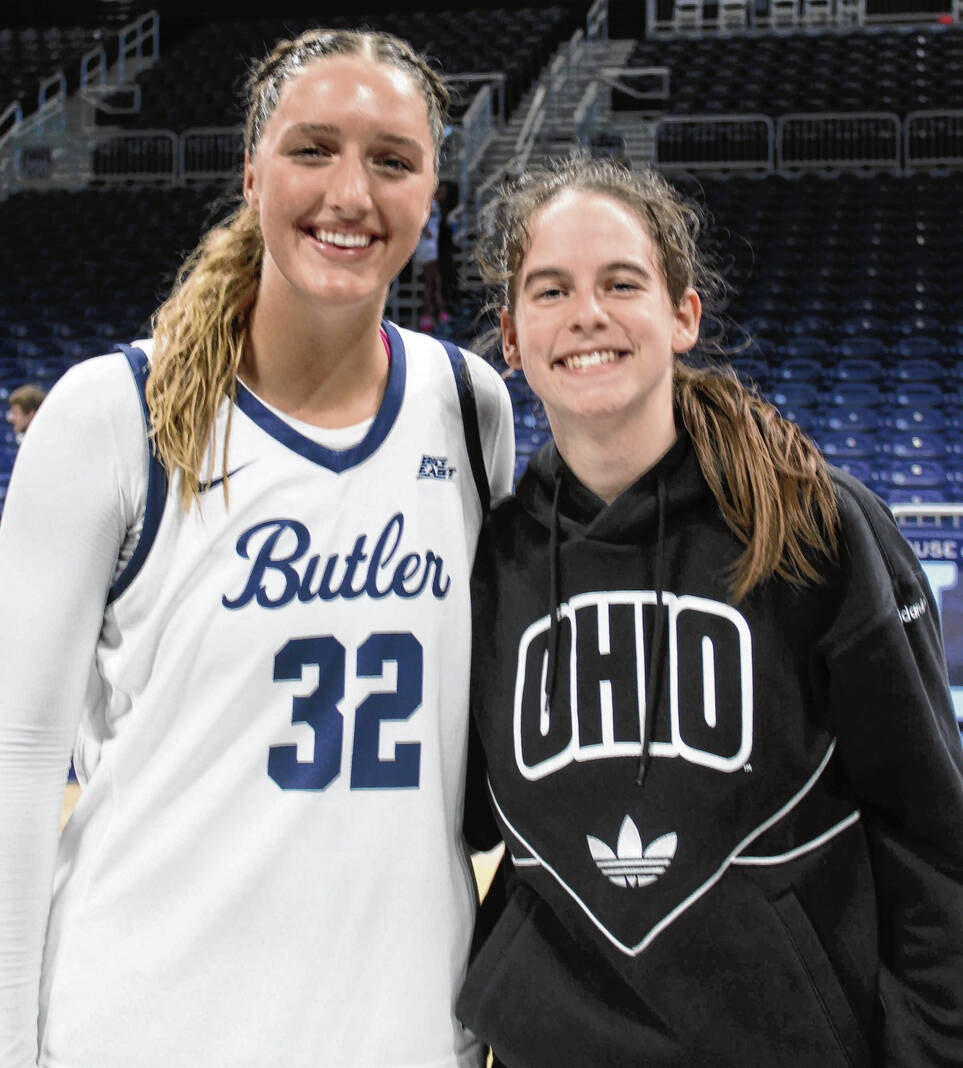
Sydney Jaynes, left, of Butler University and Bailey Tabeling of Ohio University, both played basketball under Donna Sullivan’s tutelage at Trinity Lutheran
Lew Freedman | The Tribune
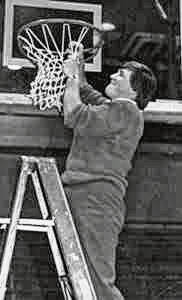
Donna Sullivan cutting down the nets in the state tournament in 1987 when Seymour High girls won a big game.
The Indiana Basketball Hall of Fame
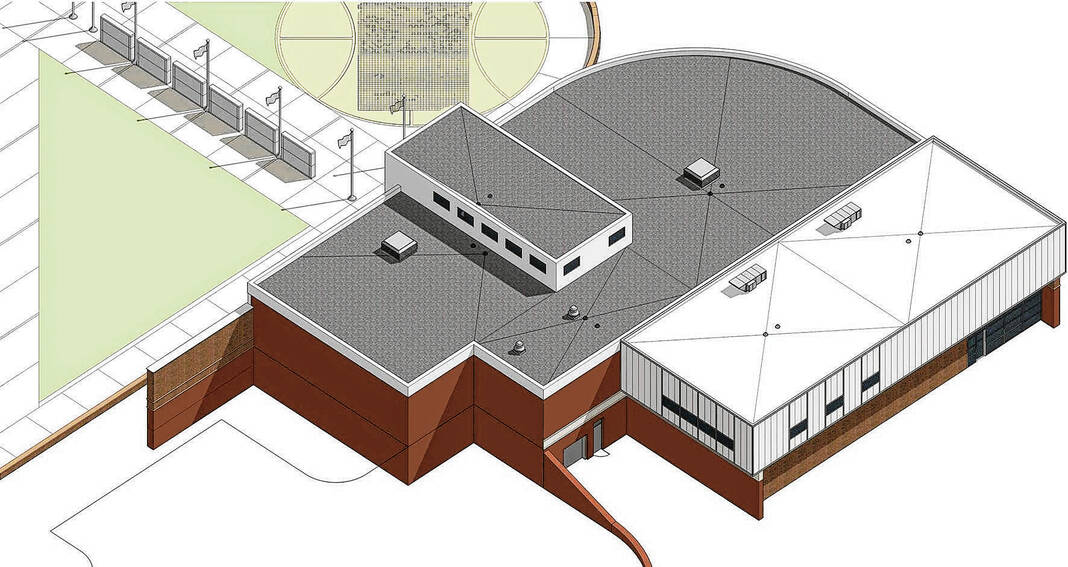
An artist’s conception of an expanded Indiana Basketball Hall of Fame scheduled to open in October.
(From the college level to the pros, in Indiana, with Seymour women playing crucial roles and around the nation, in person and on television, women’s basketball is reaching unprecedented heights of popularity propelled by Caitlin Clark and other new faces. The Tribune examines the developments in a four-part series.)
Donna Sullivan bridges the decades in Indiana girls basketball, from the past she helped author, to the future she is currently writing.
Seymour High School’s first girls team coach in the 1970s when the federal Title IX law took effect, still an assistant coach with Trinity Lutheran in Seymour, Sullivan is now the first female president of the Indiana Basketball Hall of Fame in New Castle.
In this Year of the Woman in basketball, with more eyes than ever following women’s college basketball and the WNBA, it is almost mystical timing a woman’s name is at the top of the masthead for the hall.
On Sullivan’s watch, appropriately enough, the hall is engaged in an expansion project that when it opens come fall will house more artifacts and exhibits tracing the history of girls basketball in Indiana.
“I think it’s a new era for us,” Sullivan said of what awaits on the horizon.
Sullivan has spent years on the board of directors, working her way to the top while also spending time as vice president. President since the summer of 2023 as part of a two-year term, Sullivan heads the hall’s women’s committee, searching history for possible players overlooked when girls play was relegated to a dark ages approach.
As someone who is gray-haired and 76 years old, coaching the Owls and working as an assistant at Trinity Lutheran for nine years, Sullivan has been a fixture on the Indiana basketball scene for decades and has a memory of encyclopedia proportions.
Yet Sullivan never played high school basketball. Those who have enthusiastically embraced fresh stars Caitlin Clark, Angel Reese and others might be astonished to learn when Sullivan came of age there was no real game for her to play.
For decades in the mid-20th century, girls were discriminated against, forced to compete in an altered six-on-six version of basketball, sometimes called basquette. Designed to minimize the so-called stress on girls’ stamina, only three girls at once were permitted to run into the frontcourt and try to score. The other three players were stranded on an island in the backcourt.
It took until 1995, when Oklahoma eliminated that style, for six-on-six to be phased out. Sullivan played volleyball at Indiana University instead, never indulging in what passed for girls basketball then.
“Because I didn’t like it,” she said.
Present-day college basketball players from the Seymour area have never even seen one of those odd games.
“The six-person game? I’ve never even seen video,” said Sydney Jaynes of Brownstown, who played for Trinity Lutheran and is a senior player at Butler. “That’s insane to me.”
Given the sexist background of the six-on-six game, players leading an awakening in the popularity of women’s basketball mostly don’t know it was a thing.
“Young women, old women, none of them knew it existed,” Sullivan said.
As part of the expansion, however, of the hall, which was organized in 1962 and been situated in New Castle since 1990, people will be educated.
“It’s a tremendous opportunity for us to show young ladies in our state that it (their game) wasn’t always played the same way,” Sullivan said.
Women always wanted to play
Basketball was invented during a gym class at a YMCA in Springfield, Massachusetts, in 1891 by physical education teacher Dr. James Naismith. Naismith jotted down 13 fundamental rules while using a soccer ball as the main implement.
Decades later, in December of 2010, the original rules sold at auction for $4.3 million, long after Naismith, who died in 1939, passed away, but not before he saw and liked boys high school state-tournament ball in Indiana.
There was nothing in the expensive rules that prohibited girls or women from playing. In 1892, the first women’s game was recorded at Smith College. While there is a tendency to think Sullivan has seen it all, she was not present.
One thing Sullivan is doing in her current capacity, is helping review half-hidden achievements of women who participated over the somewhat lost decades. At least one player standing out thus far is “Can’t Miss Sally” of Mount Vernon, or Sara MacGregor. Other names also are percolating to the surface.
“I have had more fun in the last two months,” Sullivan said of this glance in the rearview mirror.
The light on women’s basketball has never shined brighter than in 2024, with the NCAA tournament setting records for viewership, Indiana University continuing to excel and set its own home attendance records, and with record-setting scoring star Caitlin Clark of Iowa being drafted No. 1 overall by the Indiana Fever and already becoming a driving force for attendance increases at the pro level.
Sullivan is a season ticket-holder for IU games at Assembly Hall and she coached Hoosier coach Teri Moren when the Owls reached semi-state in 1987. Sullivan also is a season ticket-holder for Fever games — and has been since the team’s first season in 2000.
Now she is in the front lines of the hall’s expansion effort, which executive director Matt Martin considers fitting.
“It’s like the stars aligned all at once,” he said. “Donna has been pushing for equality for years.”
The hammers bang not far from Martin’s desk and may be heard in the background when consulting with Sullivan about three times a week by phone in addition to meetings in New Castle. It is projected the new exhibit space will open for public viewing in October.
“Why this expansion is going on,” Martin said, “is we have about 25 percent of our artifacts on the floor.”
The first Indiana girls high school basketball state championships were conducted at the end of the 1975-76 season. Other eras also will be showcased in the new exhibit.
“This will really highlight the history of women’s basketball in Indiana,” Martin said.
Included will be the impact of Title IX, something Sullivan was involved in first-hand. Even after the legislation was signed into law in late 1972, women had to battle on the details in equality.
Subsequently to the creation of leagues, there were confrontations over schools providing benefits for women that matched men’s, such as air travel instead of bus travel, balanced practice time in gyms, and high-quality, new uniforms.
Ask Sullivan about that. The first Seymour girls basketball players wore uniforms of T-shirts and shorts purchased in K-Mart or JC Penney’s, then had numbers ironed on for identification after the outfits were dyed purple.
Today’s players learn history
Even 52 years past approval of Title IX, Sullivan still teaches girls players what the world was like for previous generations. That is one way she has influenced a current generation of top local players.
Mike Lang first encountered Sullivan at Seymour High when he was a student and she was his teacher. Lang is now the Trinity boys coach after coaching the 1A girls team to great success — with Sullivan’s assistance.
Lang, who calls Sullivan his “mentor,” said he wanted a woman on the bench at Trinity who could share experiences.
“She is just a wealth of knowledge,” Lang said, “and the relationships she has throughout the game. She is absolutely a second mother to me.”
Jaynes, a 6-foot-3 center, became the Trinity girls’ all-time scoring leader and moved from Indiana’s smallest high school classification to NCAA Division I play. Guard Bailey Tabeling, a 5-10 sophomore at Ohio University, followed, setting a new school scoring mark and she also is competing in Division I.
Sullivan, as Hall of Fame president, Jaynes playing in Indiana, and Tabeling also playing D-I, are at the forefront of heightened women’s basketball focus and benefit at slight remove from the spotlight over what has simply been summed up as “The Caitlin Clark Effect.”
The record-setting Iowa University guard now playing for the WNBA’s Indiana Fever, galvanized women’s basketball curiosity.
“It’s skyrocketed,” Lang said.
Jaynes, 21, Tabeling, 19, and Katherine Benter, 21, from Brownstown, a senior-to-be at Division III Hanover College, sense a rise in status and an awareness about their game.
“I have to say it’s pretty amazing,” said Benter, who calls Jaynes one of her best friends from their youth. “Women in sports was never talked about. It’s kind of being part of something bigger. It’s awesome.”
Benter has heard more discussion about Title IX over the last few years than ever before, growing up, or through her first years of college.
Even if her Mid-American Conference Bobcats did not qualify for the NCAA tournament, Tabeling believes Clark’s stupendous success had a ripple effect.
“Caitlin Clark has been a big part of women athletes getting more attention,” Tabeling said. “People are seeing that us girls and women can do what men can do.”
That’s been an historical summation of women over the last century in many realms, such as gaining the right to vote (not until 1920); discarding societal norms of only being homemakers to enter the work force; seeking equal pay.
Jaynes’ college play has coincided with massive change post-Trinity, including the NCAA opening the transfer portal and Name, Image and Likeness rules being loosened by courts. Now, a half-century after Title IX kicked in, there is a deluge of enthusiasm for women’s basketball.
“Why has it taken so long?” Jaynes said. “I have been asking myself that question. It didn’t look to me it was going to get as big as it is. All of these big players (Clark and other WNBA rookies) are creating a bigger stage.”
Sullivan is right on time
For Jaynes, Sullivan becoming president of the Indiana Basketball Hall of Fame now, is special and also personal. Sullivan also coached Mary Jaynes, Sydney’s mother, as a high school player.
“She has been a pioneer for the game,” Sydney Jaynes said. “There is no better a person for it.”
Donna Sullivan cannot go back in a time machine for the Hall of Fame and erase old prejudices. What she can do is help peek through the mists shrouding the past and teach the basketball world about “Can’t Miss Sally” and other women who may have been achieving things everyone thought only men could do.
